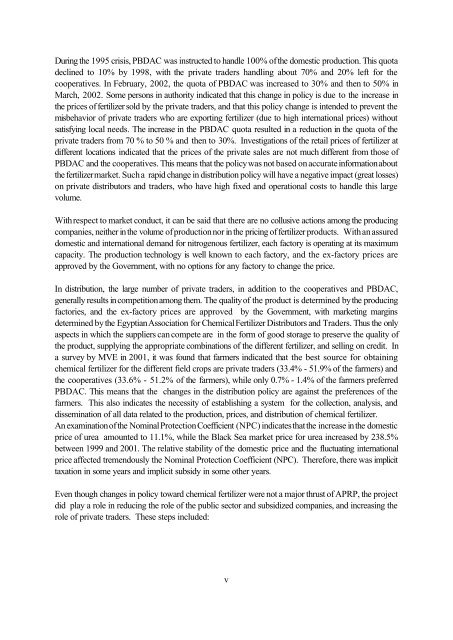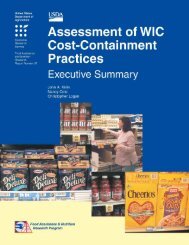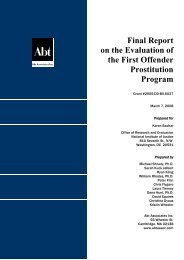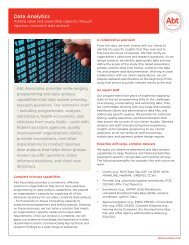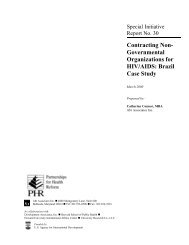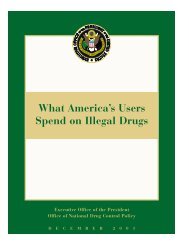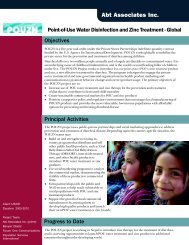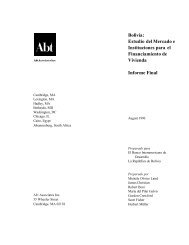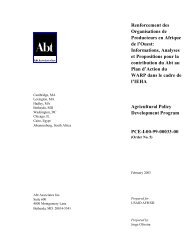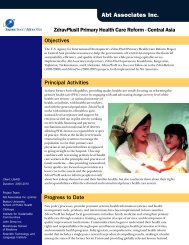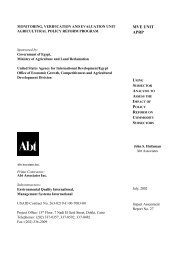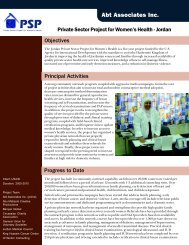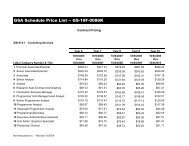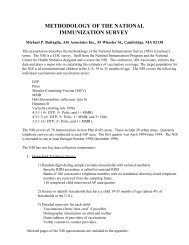Fertilizer Production And Marketing In Egypt ... - Abt Associates
Fertilizer Production And Marketing In Egypt ... - Abt Associates
Fertilizer Production And Marketing In Egypt ... - Abt Associates
Create successful ePaper yourself
Turn your PDF publications into a flip-book with our unique Google optimized e-Paper software.
During the 1995 crisis, PBDAC was instructed to handle 100% of the domestic production. This quota<br />
declined to 10% by 1998, with the private traders handling about 70% and 20% left for the<br />
cooperatives. <strong>In</strong> February, 2002, the quota of PBDAC was increased to 30% and then to 50% in<br />
March, 2002. Some persons in authority indicated that this change in policy is due to the increase in<br />
the prices of fertilizer sold by the private traders, and that this policy change is intended to prevent the<br />
misbehavior of private traders who are exporting fertilizer (due to high international prices) without<br />
satisfying local needs. The increase in the PBDAC quota resulted in a reduction in the quota of the<br />
private traders from 70 % to 50 % and then to 30%. <strong>In</strong>vestigations of the retail prices of fertilizer at<br />
different locations indicated that the prices of the private sales are not much different from those of<br />
PBDAC and the cooperatives. This means that the policy was not based on accurate information about<br />
the fertilizer market. Such a rapid change in distribution policy will have a negative impact (great losses)<br />
on private distributors and traders, who have high fixed and operational costs to handle this large<br />
volume.<br />
With respect to market conduct, it can be said that there are no collusive actions among the producing<br />
companies, neither in the volume of production nor in the pricing of fertilizer products. With an assured<br />
domestic and international demand for nitrogenous fertilizer, each factory is operating at its maximum<br />
capacity. The production technology is well known to each factory, and the ex-factory prices are<br />
approved by the Government, with no options for any factory to change the price.<br />
<strong>In</strong> distribution, the large number of private traders, in addition to the cooperatives and PBDAC,<br />
generally results in competition among them. The quality of the product is determined by the producing<br />
factories, and the ex-factory prices are approved by the Government, with marketing margins<br />
determined by the <strong>Egypt</strong>ian Association for Chemical <strong>Fertilizer</strong> Distributors and Traders. Thus the only<br />
aspects in which the suppliers can compete are in the form of good storage to preserve the quality of<br />
the product, supplying the appropriate combinations of the different fertilizer, and selling on credit. <strong>In</strong><br />
a survey by MVE in 2001, it was found that farmers indicated that the best source for obtaining<br />
chemical fertilizer for the different field crops are private traders (33.4% - 51.9% of the farmers) and<br />
the cooperatives (33.6% - 51.2% of the farmers), while only 0.7% - 1.4% of the farmers preferred<br />
PBDAC. This means that the changes in the distribution policy are against the preferences of the<br />
farmers. This also indicates the necessity of establishing a system for the collection, analysis, and<br />
dissemination of all data related to the production, prices, and distribution of chemical fertilizer.<br />
An examination of the Nominal Protection Coefficient (NPC) indicates that the increase in the domestic<br />
price of urea amounted to 11.1%, while the Black Sea market price for urea increased by 238.5%<br />
between 1999 and 2001. The relative stability of the domestic price and the fluctuating international<br />
price affected tremendously the Nominal Protection Coefficient (NPC). Therefore, there was implicit<br />
taxation in some years and implicit subsidy in some other years.<br />
Even though changes in policy toward chemical fertilizer were not a major thrust of APRP, the project<br />
did play a role in reducing the role of the public sector and subsidized companies, and increasing the<br />
role of private traders. These steps included:<br />
v


